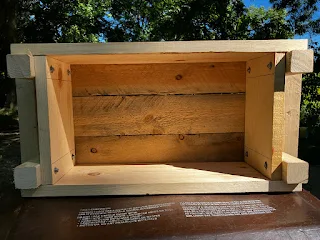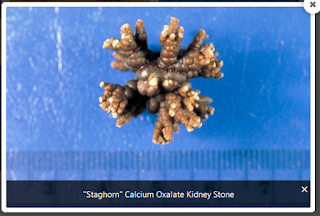One of my nephews purchased a new home and he is exploring the grounds.
He has a pear on the property and asked if it was Bartlett. Locally, most of the Bartlett pears have already fallen off the tree or are a rich yellow in color.
After a few back-and-forth emails, I guessed that it was a variety named "Kieffer".
Then, just for fun, I pulled up some descriptions from historical sources:
About 1855 Peter
Kieffer of Roxborough, Pa., planted seed from a Chinese Sand pear tree
growing in his yard and generally considered to have been pollinated by a
Bartlett tree nearby, from which the original Kieffer tree sprang.
Possibly no other pear has been so loudly praised and yet so roundly
cursed. For years after its introduction there were bitter battles waged
over the blight proof character of the tree and the high quality of the
fruit. But now that the smoke has cleared away and the issue is less
befogged by violent discussion, the virtues and faults of the Kieffer
can be more intelligently discussed.
The large-sized, symmetrical, oval
fruits, clear yellow in color, and often blushed on the side next the
sun, are attractive to the eye, but the coarse, granular, though juicy,
yellowish-white flesh is so lacking in flavor that it is rated by the
palate as 'poor in quality.' For culinary use, however, Kieffer has
virtues often forgotten or overlooked, for when canned its firm, white
flesh is attractive and pleasing. There are rumors from time to time of
Kieffer pears shipped to other countries to return in cans marked
'Bartlett,' so that perhaps the very man who decries the Kieffer the
loudest is this moment loud in his praise of a canned Kieffer under the
guise of 'Bartlett.'
There is no 'blight-proof' pear. Kieffer is as
blight-resistant as any, which amounts in some sections to the same
thing as being blight-proof. Nurserymen delight in the free, vigorous
growth of the trees, a habit that it does not cease when in the orchard.
It comes into bearing young, is resistant to scale, and bears annually
and abundantly. In fact, it is necessary to guard against the danger of
overbearing, or the reward will be nothing but small-sized fruit.
Because of the vigor of the tree and its tendency to overbear, it has
come to be the system in sections to stub the trees every year. While
this seems to be a necessary practice as the tree gets older, it will be
found that the tree will come into bearing much earlier if it can be
left to grow more to itself the first few years of its life and then be
taken into hand before it gets beyond control.
As for top-working the
Kieffer, generally speaking the operation is a failure. Most success has
been with very young trees. Possibly the chief virtue of the Kieffer
pear is its adaptability to a wide range, and especially to the warm,
dry sections of America, such as the South and the Middle West, where
the European pear, adapted as it is to cool, moist regions, will not
thrive. The nature of its seed parent exerts itself in its offspring,
and the range of pear growing is thereby greatly extended.
In some
years, Kieffers are a glut on the market, but it is noticeable the
producer of large-sized, well-matured fruits is neither worried nor
affected by low markets. Blight has taken a heavy toll from Eastern pear
orchards in recent years, so that the time may be approaching when a
higher price will prevail generally. Yet it must be affirmed that where
the better varieties can be grown it is a mistake to plant the Kieffer.
And from another source:
Grown from a seed of a
Sand Pear by Peter Kieffer of Roxborough, Pennsylvania. Presumed to be a
cross of Sand Pear and Bartlett. First fruited in 1863 and the first
Sand Pear hybrid to assume importance. It is the standard by which other
varieties of the group are judged. Fruit medium or larger in size,
ovate in form, usually pointed at both stem and calyx ends. Skin
greenish-yellow in color, often blushed dull red, numerous large russet
dots. Flesh gritty, fairly juicy, tender but not fully buttery. Fair in
dessert quality, quite satisfactory for culinary purposes. Improves in
quality if harvested at the proper time and ripened at a constant
temperature of 65 degrees F. Tree fairly vigorous, moderately productive,
somewhat resistant to fire blight. -- H. Hartman, 1957.
One magnificent thing about Kieffer pears is that they are hard when they fall and are rarely damaged by the experience, then they will cheerfully rest upon the ground for weeks without rotting. The deer leave them along until after they freeze-thaw and are thus softened. A very good variety for somebody who is an absentee land-owner.
And then, just for fun, an ancient pear called "Pound"
The cultivar
originated (was documented) around 1690. Among some of its synonyms are: Uvedale's St.
Germaine, Belle Angevine, Pound, and Bell. Pound tree bears very large
pears, which may weigh two to three pounds. Because of its weight, the
fruit often drops off the tree before it is suitable for picking. The
fruit is obovate-pyriform, yellow with pink blush on the cheek. Its
flesh is tough, subacid and has poor quality.
Pound is
grown in collections for its monstrous fruits. The pears not
infrequently weigh three pounds, and one is noted weighing four pounds,
nine ounces. The pears are course in form, texture and flavor - but one
degree better in flavor than the potato-like fruits of Kieffer and even
more sappy... This is a very old pear of uncertain origin, possibly
dating back to Pliny, who wrote about eighty years after the beginning
of the Christian era. -- U.P. Hedrick, Cyclopedia of Hardy Fruits, 1922.
Another description
Pound. Only valued for
cooking. Synonyms: Abbe Mongein, Anderson, Angora, Beute de Tervueren,
Beauty of Turvueren, Beauty of Turvensen, Belle Angevine, Belle de
Jersey, Bellisime d'Hives du Bur, Berthebirn, Bolivar, Bolivar d'Hiver,
Bretagne le Cour, Chamber's Large, Comice de Toulon, Comtesse de
Terweuren, Cordelier, D'Horticulture, Dr. Udale's Warden, Duchesse de
Berry, Duchesse de Berry d'Hiver, DuTonneau, English Bell, Faux Bolivar,
Funtovka, German Baker, Gros fin or long d'Hiver, Grosse Dame Jeanne,
Grosse de Bruxelles, La Quintyne, Large Cordelier, Lent St. Germain,
Louise Bonne d'Hiver, Pfundbirne, Pickering Pear, Pickering Warden,
Piper, Poirie Angora, Royal d'Angleterre, Union, Uvedale's St. Germain,
Uvedale's Warden, Winter Bell. -- W.H. Ragan, Nomenclature of the Pear,
1908.
In general, the more synonyms a cultivar has, the longer it has been in existence and the better it is.
Pound Pear. This is
one of the largest winter pears, it sometimes weighs from twenty-six to
twenty-eight ounces - the form is regular, full and round at the crown,
lessening gradually towards the stem, which is long and large - the skin
is green, with a brown cheek; it becomes yellow, and the cheek takes a
lively red when kept from the air towards the spring; it has a firm
flesh, which becomes red like a quince when cooked, for which purpose
only, it is preserved through the winter - it is a great bearer; the
tree grows large, and is very hardy; these pears should be suffered to
hang on the tree as late as possible, they may be kept in bran, chaff or
paper, excluded from the air, which preserves their fullness, renders
them more juicy and tender, and gives them a fine colour. -- W. Coxe, A
view of the cultivation of fruit trees, 1817.
I have been given to understand that in medieval times pears (and perhaps apples) were eaten cooked more often than fresh. Given the state of dental science, that is very easy to imagine. Hard pears and apples store much longer than tender "table" apples and pears.


 e
e






















.png)
.png)
.png)
.png)
.png)












%20-%20USGS%20Forest%20Service%20Native%20Range%20Map.jpg)
